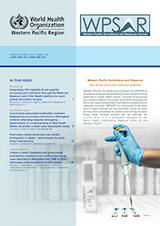Integrating HIV, hepatitis B and syphilis screening and treatment through the Maternal, Newborn and Child Health platform to reach global elimination targets
DOI:
https://doi.org/10.5365/wpsar.2017.8.3.005Abstract
Every year, an estimated 180 000 babies in the Western Pacific Region are infected by hepatitis B, 13 000 by syphilis and 1400 by HIV through mother-to-child transmission. (1) These infections can be largely prevented by antenatal screening, treatment and timely vaccination for newborns. Despite challenges in controlling each disease, major achievements have been made. National immunization programmes have reduced the regional hepatitis B prevalence from over 8% in 1990 to 0.93% among children born in 2012. In addition, HIV testing and treatment have helped keep the regional prevalence of HIV infections at 0.1%. In contrast, the number of maternal syphilis cases is still high in the Western Pacific Region, with an estimated 45 million cases in 2012. Elimination of mother-to-child transmission of these infections cannot be achieved through vertically applied programming and require using and augmenting to the shared Maternal, Newborn and Child Health platform to coordinate, integrate and enable cost efficiencies for these elimination efforts. The Regional Framework for Triple Elimination of Mother-to-Child Transmission of HIV, Hepatitis B and Syphilis in Asia and the Pacific 2018–2030 offers such a coordinated approach towards achieving the triple elimination of mother-to-child transmission of HIV, hepatitis B and syphilis and provides guidance for decision-makers, managers and health professionals working in programmes addressing maternal, newborn and child health, HIV, hepatitis, sexually transmitted infections and immunization.
References
Regional framework for the triple elimination of mother-to-child transmission of HIV, hepatitis B and syphilis in Asia and the Pacific 2018-2030 [DRAFT], World Health Organization. Available from http://www.wpro.who.int/about/regional_committee/68/documents/wpr_rc68_7_annex_hiv_hepa_syphilis.pdf?ua=1 [cited 2017 09 September]
Global health sector strategy on HIV, 2016–2021. Geneva, Switzerland: World Health Organization; 2016. Available from http://apps.who.int/iris/bitstream/10665/246178/1/WHO-HIV-2016.05-eng.pdf [cited 2017 09 September]
Global health sector strategy on viral hepatitis, 2016–2021. Geneva, Switzerland: World Health Organization; 2016. Available from http://apps.who.int/iris/bitstream/10665/246177/1/WHO-HIV-2016.06-eng.pdf?ua=1. [cited 2017 09 September]
Global health sector strategy on sexually transmitted infections, 2016–2021. Geneva, Switzerland: World Health Organization; 2016. Available from http://apps.who.int/iris/bitstream/10665/246296/1/WHO-RHR-16.09-eng.pdf [cited 2017 09 September]
Wijesooriya NS, Rochat RW, Kamb ML, Turlapati P, Temmerman M, Broutet N et al. Global burden of maternal and congenital syphilis in 2008 and 2012: a health systems modelling study. Lancet Glob Health. 2016 Aug;4(8):e525-33. doi: 10.1016/S2214-109X(16)30135-8. PMID: 27443780
Global AIDS Monitoring 2017. Available from http://www.unaids.org/sites/default/files/media_asset/2017-Global-AIDS-Monitoring_en.pdf [cited 2017 09 September]
UNICEF Data: Monitoring the Situation of Children and Women. Available from http://data.unicef.org/topic/maternal-health/antenatal-care [cited 2017 31 May]
WHO and UNICEF Joint Reporting Form of 2017. Available from http://apps.who.int/immunization_monitoring/globalsummary/timeseries/tscoveragedtp3.html [cited 2017 31 May]
Wiesen E, Diorditsa S, Li X. Progress towards hepatitis B prevention through vaccination in the Western Pacific, 1990-2014. Vaccine. 2016 May 27;34(25):2855-62. doi: 10.1016/j.vaccine.2016.03.060. PMID: 27020710.
Nayagam S, Thursz M, Sicuri E, Conteh L, Wiktor S, Low-Beer D, et al. Requirements for global elimination of hepatitis B: a modelling study. Lancet Infect Dis. 2016 Dec;16(12):1399-408. doi: 10.1016/S1473-3099(16)30204-3. PMID: 27638356
Global guidance on criteria and processes for validation. Elimination of mother-to-child transmission of HIV and syphilis. Geneva: World Health Organization; 2014. Available from: http://apps.who.int/iris/bitstream/10665/112858/1/9789241505888_eng.pdf [cited 2017 10 Sept]
Wang AL, Qiao YP, Wang LH, Fang LW, Wang F, Jin X et al. Integrated prevention of mother-to-child transmission for human immunodeficiency virus, syphilis and hepatitis B virus in China. Bull World Health Organ. 2015 Jan 1;93(1):52-6. doi: 10.2471/BLT.14.139626. PMID: 25558108

